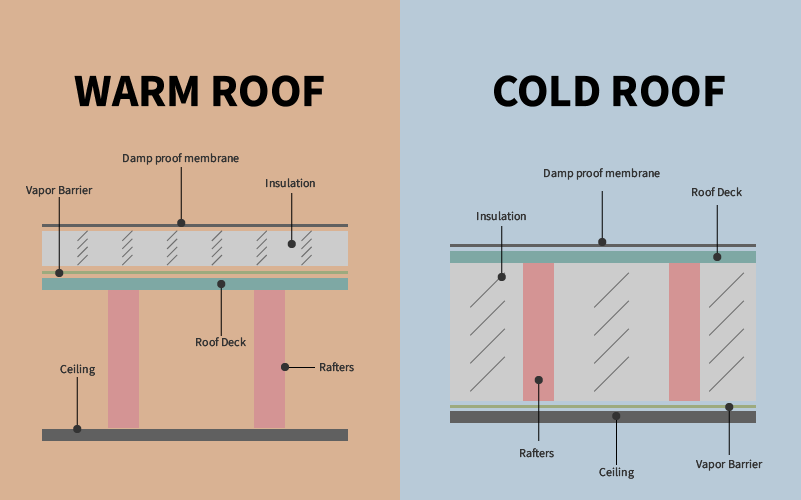The roof of your home plays a vital role in energy efficiency, comfort, and protection from the elements. In the UK, where the climate is notoriously unpredictable and often damp, the decision between warm roof construction and cold roof construction is crucial. Among the two, warm roof construction has become the preferred choice for many homeowners and builders due to its superior performance in insulation, moisture management, and energy savings.
In this blog post, we’ll explore the differences between warm and cold roof construction and explain why warm roof construction is the better choice for properties in the UK.
What Is Warm Roof Construction?
A warm roof places the insulation layer above the roof deck or structural elements, creating a thermal barrier that protects the entire roof structure. This design keeps the roof deck and structural elements warm, reducing the risk of condensation and thermal bridging.
Key Features of Warm Roofs:
- Insulation is placed above the roof deck.
- No ventilation is required, as the structure stays within the building's thermal envelope.
- A vapour control layer (VCL) is installed beneath the insulation to manage moisture.
What Is Cold Roof Construction?
A cold roof positions the insulation layer below the roof deck, leaving the roof deck and structural elements exposed to external temperatures. This requires adequate ventilation to prevent condensation and moisture build-up, which can lead to long-term damage.
Key Features of Cold Roofs:
- Insulation is installed between or below the roof joists.
- Requires ventilation to prevent condensation.
- Structural elements are colder and more prone to thermal bridging.
Top 5 Reasons to Choose Warm Roof Construction in the UK
1. Superior Thermal Performance
The UK’s climate demands effective insulation to maintain comfortable indoor temperatures. Warm roofs provide a continuous insulation layer that minimizes thermal bridging, significantly reducing heat loss.
- Benefit: Lower heating bills and a more energy-efficient home.
- Example: In a warm roof, the insulation wraps the roof deck, ensuring that heat stays inside during winter.
2. Moisture and Condensation Control
Cold roofs require ventilation to manage condensation, but the UK’s high humidity levels can make this less effective. Warm roofs, by contrast, eliminate condensation risks by keeping the entire roof structure warm and within the building's thermal envelope.
- Benefit: Reduced risk of damp, mould, and rot in the roof structure.
3. Easier Installation and Compliance
Warm roofs are easier to install and often align more closely with UK Building Regulations for energy efficiency and moisture control.
- Benefit: Fewer complexities in achieving compliance compared to cold roofs, which require precise ventilation systems.
4. Extended Roof Lifespan
By protecting the roof deck and structural elements from extreme temperature fluctuations, warm roof construction helps prevent thermal stress and extends the lifespan of your roof.
- Benefit: A durable roof that requires fewer repairs over time.
5. Ideal for Flat Roofs
Flat roofs are common in UK extensions, garages, and commercial buildings, and warm roof construction is particularly suited to flat roofs. It provides a seamless insulation layer that improves performance and avoids the ventilation challenges associated with cold flat roofs.
- Benefit: A more robust and energy-efficient solution for flat roof applications.
When Might a Cold Roof Be Appropriate?
Cold roof construction is less common in new builds but may be considered for refurbishment projects where:
- The roof design makes it challenging to add insulation above the roof deck.
- Ventilation can be installed effectively to manage condensation.
However, even in these scenarios, the long-term benefits of converting to a warm roof often outweigh the challenges.
Warm Roof Construction with RoofGuard.ai
At RoofGuard.ai, we believe in using technology to make roofs smarter, safer, and more efficient. Our AI-driven tools can assess your roof’s energy efficiency and help you decide whether upgrading to a warm roof construction is the right choice for your property.
Conclusion
In the UK, where energy efficiency and moisture control are key concerns, warm roof construction offers clear advantages over traditional cold roof methods. By providing superior insulation, reducing condensation risks, and enhancing durability, warm roofs are a smart investment for any homeowner or builder.
If you're considering upgrading your roof or planning a new build, consult with roofing professionals and explore the benefits of a warm roof design. For more insights and cutting-edge tools for roof management, visit RoofGuard.ai today!

